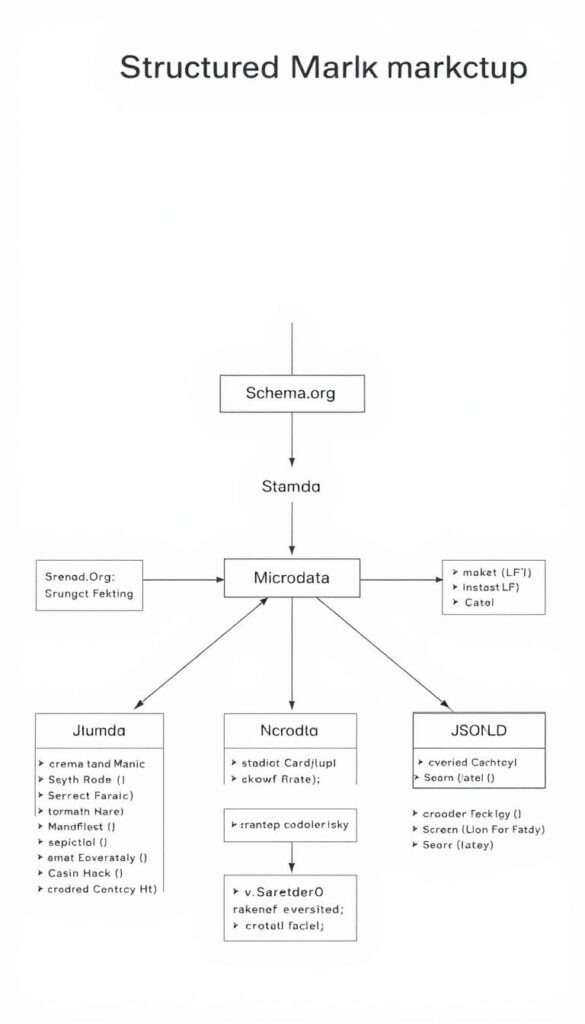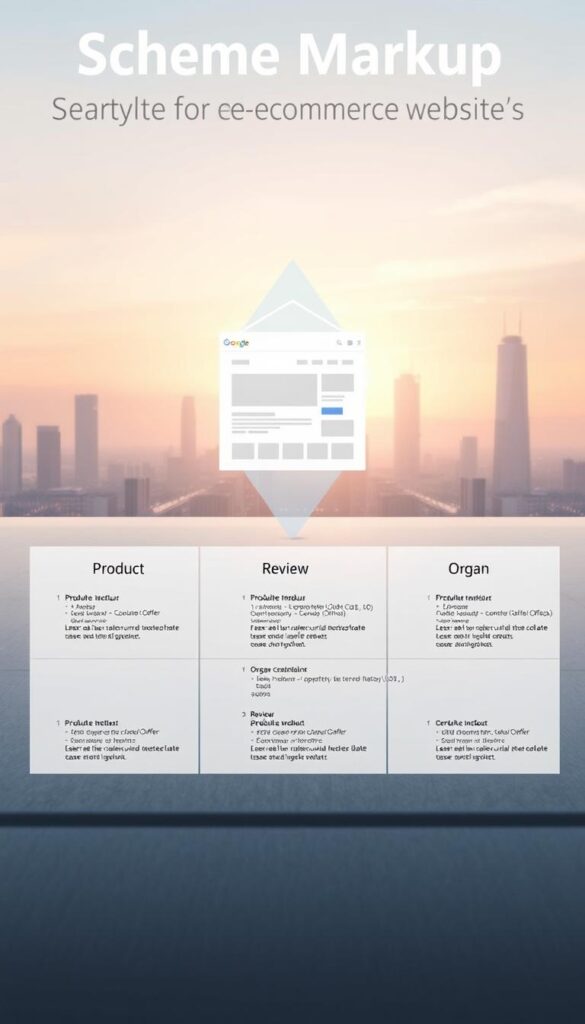
In today’s digital world, having an online presence is key for businesses and people. Search engine optimization (SEO) is a powerful tool to boost this presence. It uses various methods to make web pages more visible and ranked higher in search results.
Structured data markup is a big part of SEO. It’s a standard way to share information about a page and its content. Google Search Central says it helps search engines get what a page is about. This leads to better indexing and more relevant search results.
Using structured data markup gives search engines more context about our content. This boosts our online visibility and brings more targeted visitors to our sites.
Key Takeaways
- Structured data markup is essential for enhancing online presence.
- It helps search engines understand the content of a webpage.
- Better indexing leads to more relevant search results.
- Improved visibility drives targeted traffic to websites.
- SEO strategies should include structured data markup for optimal results.
What is Structured Data Markup?
As we explore SEO, it’s key to grasp what structured data markup is. It boosts our online presence.
Understanding Structured Data
Structured data uses in-page markup on the page it applies to, as Google Search Central explains. This markup helps search engines like Google, Bing, and Yahoo understand our webpage’s content.
By adding this context, we can make search engines show more detailed and relevant results. This can up our website’s visibility and click-through rates.
How It Works
Structured data gives search engines extra context about our webpage’s content. This can include things like reviews, business hours, or product info. It makes it easier for search engines to show relevant results to users.
For example, on an e-commerce site, we can highlight product reviews, prices, and availability. This makes our product listings more appealing in search engine results.
Common Formats
There are several ways to use structured data markup, including JSON-LD, Microdata, and RDFa. Each has its own benefits and fits different needs.
JSON-LD is a JavaScript-based format that’s widely supported. It’s easy to use, especially for those who know JavaScript.
Microdata is embedded in a webpage’s HTML. It’s great for marking up specific page elements.
RDFa offers flexibility in data representation. It’s good for complex data structures.
| Format | Description | Complexity |
|---|---|---|
| JSON-LD | JavaScript-based, easy to implement | Low |
| Microdata | Embedded within HTML, useful for specific elements | Medium |
| RDFa | Flexible, complex data representation | High |
To better understand, let’s look at a visual example of structured data markup:
Knowing the different formats helps us choose the best one for our website. This improves our online presence and search engine visibility.
Why We Should Use Structured Data
Using structured data can greatly improve our website’s visibility in search results. It helps search engines understand our web pages better. This makes it easier for users to find us.

Improving Search Engine Visibility
One big benefit of structured data is that it improves our search engine visibility. It gives search engines more context about our content. This increases our chances of showing up in relevant search results.
In today’s competitive online world, standing out is key. It’s important for driving traffic to our site.
Enhancing Click-Through Rates
Structured data also helps enhance click-through rates. When our search results have more information, like reviews or event details, they look more appealing to users.
This can lead to more engagement and visits to our website.
Boosting Rich Snippets
Another big advantage of structured data is its ability to boost rich snippets. Rich snippets are enhanced search results that give users more info about our content.
By using structured data markup, we can make our search results more likely to be rich snippets. This makes them more noticeable and attractive to potential visitors.
As Google Search Central notes, “Adding structured data can enable search results that are more engaging to users and might encourage them to interact more with your website.”
Types of Structured Data Markup
Exploring structured data markup shows its importance for SEO. It’s not a single solution but various formats for different needs. Each format suits different websites and content types.
Schema.org Overview
Schema.org is a joint effort by Google, Bing, Yahoo, and Yandex. It aims to offer a common language for structured data. It has schemas for many content types, like events, reviews, and products. Using schema.org helps search engines better understand our content.
Key benefits of schema.org include:
- Enhanced search engine understanding
- Improved visibility in search results
- Support for a wide range of content types

⭐️ Tap the exclusive deal link https://temu.to/k/uot8tcxvwum to score top-quality items at ultra-low prices. 🛍️ These unbeatable deals are only available here. Shop now and save big! ⭐️ Directly get exclusive deal in Temu app here: https://app.temu.com/m/mhb5rstagbx
Another surprise for you! Click https://temu.to/k/uag0bn0o0wd to earn with me together🤝!
JSON-LD, Microdata, and RDFa
There are three main ways to use structured data markup: JSON-LD, Microdata, and RDFa. Google suggests JSON-LD for most sites. It’s simpler to set up and keep up.
Here’s a quick look at each format:
- JSON-LD: A lightweight, JavaScript-based format that is easy to implement and maintain.
- Microdata: A specification for embedding metadata within HTML content.
- RDFa: A W3C recommendation that extends HTML with additional attributes for embedding metadata.
Choosing the Right Type for Us
Choosing the right structured data markup depends on our needs and website setup. We should think about how easy it is to use, maintain, and the content we’re marking up.
To choose the right type:
- Consider the complexity of your content
- Evaluate the ease of implementation and maintenance
- Assess the support for your content type
Understanding and picking the right structured data markup can boost our website’s visibility. It also helps improve our SEO strategy.
Benefits of Implementing Structured Data
Adding structured data makes it easier for search engines to understand and show our content. This can lead to many benefits that help us stand out online.
Increased Organic Traffic
Structured data markup is great for boosting organic traffic. It gives search engines a clear view of our content through semantic markup. This makes our site more visible in search results.
Studies show sites with structured data get more clicks than those without. This is because structured data makes search results better, like rich snippets and knowledge panels.
Better User Experience
Structured data also makes the user experience better. It helps search engines find the most relevant content for users. This leads to happier users, lower bounce rates, and more engagement.
“Structured data helps search engines understand the context of your content, leading to better indexing and more relevant search results.”
Simplifying Data Sharing
Another big plus of structured data is it makes sharing data easier. Using formats like schema.org and JSON-LD, we can share and reuse data easily. This makes data more accessible and useful everywhere.
| Benefits | Description | Impact |
|---|---|---|
| Increased Organic Traffic | Improved search engine understanding and display of content | Higher visibility and click-through rates |
| Better User Experience | More relevant content direction | Improved user satisfaction and engagement |
| Simplifying Data Sharing | Standardized data formats for easy sharing | Enhanced data accessibility and reuse |
The benefits of structured data are clear and can really boost our online presence. By using these benefits, we can improve our SEO and get more visitors to our site.

How to Get Started with Structured Data
Structured data markup is a great way to make your website more visible in search engines. We’re here to help you get started. First, you need to know about the tools and resources available to you.
Tools and Resources We Need
To use structured data markup well, you’ll need some tools and resources. Google’s Structured Data Markup Helper is a great tool for creating the markup you need. It’s also important to know about JSON-LD, Microdata, and RDFa.
Here are some key tools and resources:
- Google Structured Data Markup Helper
- Schema.org documentation
- JSON-LD, Microdata, and RDFa guides
Steps to Implement
To start using structured data markup, follow these steps:
- Find out what type of schema markup you need for your content.
- Use the Schema.org documentation to learn about the properties and structure needed.
- Decide on the best format for your markup (JSON-LD, Microdata, or RDFa).
- Use tools like Google’s Structured Data Markup Helper to create the markup.
- Add the markup to your website’s HTML.
For example, if you’re marking up a product, your JSON-LD might look like this:
{
"@context": "https://schema.org/",
"@type": "Product",
"name": "Example Product",
"image": [
"https://example.com/photos/1x1/photo.jpg",
"https://example.com/photos/4x3/photo.jpg",
"https://example.com/photos/16x9/photo.jpg"
],
"description": "This is an example product.",
"sku": "0446310786",
"mpn": "925872",
"brand": {
"@type": "Brand",
"name": "Example Brand"
}
}
Testing Our Markup
After adding structured data markup, test it to make sure it’s working right. Google’s Rich Results Test is a good tool for this.
Here’s a look at different testing tools:
| Tool | Purpose | Features |
|---|---|---|
| Google Rich Results Test | Tests if your page is eligible for rich results | Easy to use, detailed error reporting |
| Schema.org Validator | Validates schema markup | Provides detailed validation results |
By following these steps and using the right tools, you can make your website more visible in search engines.

Best Practices for Structured Data Markup
To get the most out of structured data, we need to follow best practices. It’s not just about adding code to our site. It’s about making sure search engines get our content right. By doing this, we can make our site more visible, improve user experience, and get more visitors.
Syntax and Formatting Guidelines
When we use structured data, it’s important to stick to the rules. This means using the right format, like JSON-LD, and making sure our code is correct. Google likes JSON-LD because it’s easy to use.
Here are some key guidelines to follow:
- Use the correct schema.org vocabulary for our markup.
- Ensure that our markup is consistent across our website.
- Test our markup regularly to catch any errors.
Avoiding Common Mistakes
Making mistakes in structured data can hurt our site’s performance. Some common errors include:
- Incorrect or missing required properties.
- Using outdated or deprecated schema types.
- Markup that is not consistent with the content on the page.
To avoid these mistakes, we should regularly review and update our markup. This keeps it accurate and up-to-date with the latest rules.
Keeping Our Markup Updated
It’s crucial to keep our structured data markup current. We need to stay on top of changes to schema.org and Google’s rules. We should also watch how our site is doing and tweak our markup as needed.

By following these best practices, we can make sure our structured data keeps improving our online presence. This helps our business grow and succeed.
Structured Data Markup for E-commerce
Structured data markup helps e-commerce sites stand out. It’s key in a competitive online market. Being visible in search results can boost sales.

Product Schema Implementation
Adding product schema is crucial for e-commerce sites. It involves special code on product pages. This code gives search engines detailed product info, like prices and reviews.
Key elements of product schema include:
- Product name and description
- Pricing and currency
- Availability and stock levels
- Reviews and ratings
How It Drives Sales
Structured data markup boosts product visibility. Rich snippets, made from this data, give more info to shoppers. This makes them more likely to buy.
For instance, a product rich result might display:
- Pricing and availability
- Customer reviews and ratings
- Product images
Case Studies of Success
Many e-commerce sites have seen big improvements. They’ve gotten better search rankings and more sales. A study showed product rich results can lead to more leads and interest.
Some successful examples include:
- E-commerce sites with more organic traffic
- Businesses with higher click-through rates from rich snippets
- Companies with better brand visibility from detailed product info
Structured Data for Blogging
Structured data is key in SEO for bloggers. It helps search engines understand our content better. This makes our blog posts more visible and relevant.
Enhancing Article Visibility
Structured data helps search engines get our articles’ context right. This leads to enhanced visibility in search results. Search engines can show our content to users looking for similar topics.
For example, schema markup for articles shows the title, author, and date in search results. This makes our content more attractive and gives users quick info.

Schema Markup for Reviews
Reviews are vital for many blogs, especially those about products or services. Using schema markup for reviews gives search engines structured data. This data highlights our review’s key points, like ratings and summaries.
This data can create rich snippets in search results. Rich snippets make our reviews pop and might boost click-through rates.
Attracting More Readers
The main goal of blogging is to engage with our audience. Structured data helps by making our content easier to find and more appealing in search results.
By adding relevant schema markup, we can rank higher in search engine results. This drives more organic traffic to our site.
| Benefits of Structured Data for Blogging | Description |
|---|---|
| Enhanced Visibility | Improved indexing and display in search results |
| Rich Snippets | Enhanced search results with additional information |
| Increased Engagement | More attractive and informative search results |
Measuring the Impact of Structured Data
When we add structured data markup, it’s important to see how it changes our online presence. This step helps us know if our work in search engine optimization is paying off.
To really measure this impact, we need the right tools. Tools like Google Search Console help us watch how our new pages do. This lets us see if our semantic markup is working well.
Tools to Analyze Performance
There are many tools to check how our structured data is doing. Google Search Console is a key tool that shows us how our pages do in search results. Google Analytics also helps us see how much traffic and engagement our site gets.
With these tools, we can really understand how our structured data affects our site’s visibility and how users interact with it.
Key Metrics We Should Track
To see how our structured data is doing, we need to watch a few important metrics. These are:
- How much organic traffic our site gets
- How many people click on our site from search results
- Where our pages rank in search results
- How long people stay on our site and if they leave quickly
By keeping an eye on these metrics, we can tell if our structured data is making our site better.

Adjusting Our Strategies
If our data shows we need to make changes, we should. This might mean improving our schema markup, adding structured data to more pages, or fixing any mistakes found by our tools.
Keeping an eye on our data and making changes as needed is crucial. This way, our site stays optimized for search engines and offers a great experience for users.
Future Trends in Structured Data
Structured data is changing fast, thanks to voice search and artificial intelligence. It’s key to know the new trends that will shape its future.
Voice Search and Structured Data
Voice search is getting more popular, with people using Siri, Google Assistant, and Alexa to search online. This change affects structured data a lot. Search engines use it to give good answers to voice questions.
To do well with voice search, we must make structured data sound natural. We should use long-tail keywords that match how we talk, not just type.
“The rise of voice search is a game-changer for structured data. It’s no longer just about providing information; it’s about providing the right information in the right format at the right time.”
The Role of AI and Automation
Artificial intelligence (AI) and automation are big in structured data now. Search engines use AI to understand web pages better and give better search results.
As AI gets smarter, we’ll see more advanced uses of structured data. This includes better entity recognition, enhanced semantic search, and more accurate results.

Preparing for Changes in SEO Algorithms
SEO algorithms are always changing, and so is structured data markup. To stay ahead, we must adapt our strategies as search engines update their rules.
We should keep up with the latest structured data and SEO tips. We should also be open to trying new things. This way, our structured data will keep working well and help our online presence.
Some ways to get ready for SEO algorithm changes include:
- Stay informed about new structured data and SEO trends.
- Check and update our structured data regularly to keep it current.
- Be ready to change our strategies as search engines evolve.
Resources for Continuing Learning
To get better at structured data markup, there are many resources out there. We can use them to boost our skills in semantic markup and data highlighting. This will help us improve our online presence.
Online Courses and Tutorials
Google Search Central and schema.org have great guides and tutorials. They help us learn the latest in structured data markup. This keeps us up-to-date with the best practices.
Community Forums and Support
Joining community forums and support groups is very helpful. We can learn from others and share our own experiences. This builds a community of learners.
Keeping Up with Industry News
It’s important to stay current with structured data markup news. Following industry leaders and news outlets helps us. We can always improve our strategies for data highlighting and semantic markup.



